Higher Economic Decline for Albania in 2020
According to new forecasts recently released by the Vienna Institute for International Economic Studies, the recovery of Eastern European economies, including Albania, will be slow and will depend on success in managing the pandemic without applying blocking measures, as well as continued support for measures by governments.
In the new forecasts, the Vienna Institute reports that the Albanian economy will decline by 6.4% in 2020 compared to -5% according to forecasts of May 2020, while it has increased expectations for the performance of the economy in 2021 by 0.8% points.
According to Vienna experts, the country's economy will grow by 4.6% next year. In the region, Montenegro is expected to have the biggest economic decline with 9% due to high dependence on tourism. After Montenegro, the second in the region for the depth of the decline is Albania and then North Macedonia. The decline for Serbia will be softer, as Vienna experts predict a 2% contraction.
Vienna experts analyze that most economies in Eastern Europe withstood the first wave of the pandemic better than Western Europe, but many economies in the region such as Croatia, Montenegro and Albania felt the consequences more due to high exposure to the tourism sector. However, the second accelerating wave of the pandemic brought about the restoration of restrictions, which may intensify in the coming months, making the deep fall already certain.
Vienna economists believe that the medium-term outlook is extremely uncertain. After an estimated contraction of 4.5% this year, the region should grow by 3.1% in 2021 and by 3.3% in 2022. In this scenario, only Lithuania, Serbia and Turkey will reach 2019 levels before 2022, while Montenegro, Croatia and Albania will want more time. In addition to the potential for stricter restrictions in the winter months, the pandemic will have long-term consequences on consumption, leading to depression of some services, such as aviation, hotels and recreation.
The Vienna Institute advised that further support from governments is needed throughout the region. After the lifting of restrictions in the third quarter, retail trade grew driven by missing purchases during the lockdown, and international production chains resumed operations.
However, pre-crisis levels of economic activity have not been reached. In addition, the second wave of the pandemic, which began in many Central, Eastern and Southeastern Europe (CESEE) countries in September, has raised concerns about the ability of health care systems to cope with the growing number of hospitalizations.
In the baseline scenario, which assumes that a vaccine will curb the pandemic without the need for long restrictions, CESEE economies are projected to grow by an average of 3.1% in 2021 and 3.3% in 2022.
(Source: Monitor)













